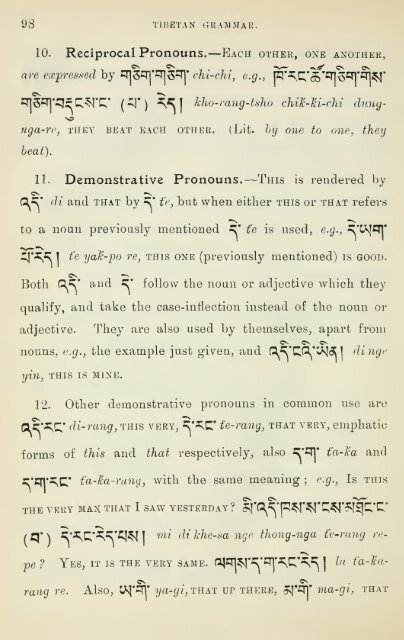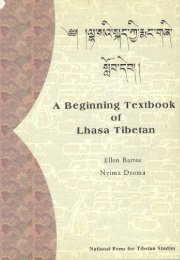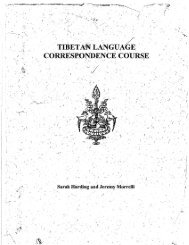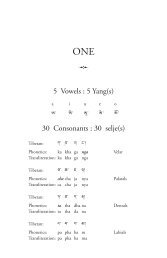Grammar of colloquial Tibetan - learning tibetan
Grammar of colloquial Tibetan - learning tibetan
Grammar of colloquial Tibetan - learning tibetan
You also want an ePaper? Increase the reach of your titles
YUMPU automatically turns print PDFs into web optimized ePapers that Google loves.
98 TIBETAN GRAMMAR.<br />
10. Reciprocal Pronouns.<br />
—<br />
Each other, oxe another,<br />
are expressed hj ^^^^]^'^^^^\' chi-chi, e.g., ^^ZJ^'^^^V^]^:^'<br />
^1^2^'Klf C;^'E;' (^'j ^^1<br />
Jcho-rang-tsho chiJc-lci-chi dnny-<br />
nga-rc, they beat each other. (Lit. hy one to one, they<br />
heat).<br />
11. Demonstrative Pronouns,<br />
—<br />
This is rendered by<br />
CU\' di and that by ^' te, but when either this or that refers<br />
to a noun previously mentioned ^' t'e is used, e.g., ^^^<br />
^'^S 1 ^^ yaJc-'po re, this one (previously mentioned) is good.<br />
Both Q>^' and ST* follow the noun or adjective which they<br />
qualify, and take the case-inflection instead <strong>of</strong> the noun or<br />
adjective. They are also used by themselves, apart from<br />
nouns, e.g., the example just given, and Q^'C^Q.'ys|(3; ! di nge<br />
yin, this is mine.<br />
12. Other demonstrative pronouns in common use are<br />
Qc'i^C;' di-rang, this very, ^'^C t'e-mng, that very, emphatic<br />
forms <strong>of</strong> this and that respectively, also ^'^* ta-Ka and<br />
Jn'STI'^C t'a-Jca-rany, with the same meaning ; e.g., Is this<br />
the very man that I SAW YESTERDAY? S^'Q^^'p^'^'C^^'^I^C^'C^'<br />
(i^') ^'-^C^'-^^'^^ I<br />
"^"^i dihhe-sa ngt' thong-nga t'e-rang re-<br />
pe ? Yes, it is the very same. (^^n^'^'^j'^C'^^ ]<br />
l(i ta-Ha-<br />
rang re. Also, y^'^1* ya-gi,i:R\T up there, ^W ma-gi, that








